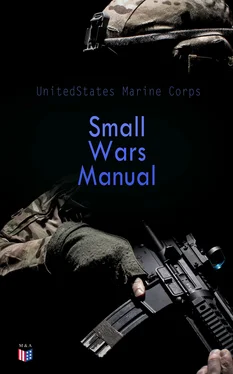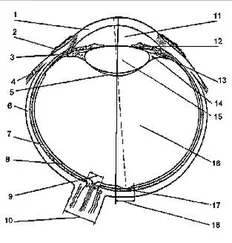Table of Contents
1-7. The basis of the strategy.
Table of Contents
a. The military strategy of small wars is more directly associated with the political strategy of the campaign than is the case in major operations. In the latter case, war is undertaken only as a last resort after all diplomatic means of adjusting differences have failed and the military commander’s objective ordinarily becomes the enemy’s armed forces.
J. Diplomatic agencies usually conduct negotiations with a view to arriving at a peaceful solution of the problem on a basis compatible with both national honor and treaty stipulations. Although the outcome of such negotiations often results in a friendly settlement, the military forces should be prepared for the possibility of an unfavorable termination of the proceedings. The mobilization of armed forces constitutes a highly effective weapon for forcing the opponent to accede to national demands without resort to war. When a time limit for peaceful settlement is prescribed by ultimatum the military-naval forces must be prepared to initiate operations upon expiration of the time limit.
c. In small wars, either diplomacy has not been exhausted or the party that opposes the settlement of the political question cannot be reached diplomatically. Small war situations are usually a phase of, or an operation taking place concurrently with, diplomatic effort. The political authorities do not relinquish active participation in the negotions and they ordinarily continue to exert considerable influence on the military campaign. The military leader in such operations thus finds himself limited to certain lines of action as to the strategy and even as to the tactics of the campaign. This feature has been so marked in past operations, that marines have been referred to as State Department Troops in small wars. In certain cases of this kind the State Department has even dictated the size of the force to be sent to the theater of operations. The State Department materially influences the strategy and tactics by orders and instructions which are promulgated through the Navy Department or through diplomatic representatives.
d. State Department officials represent the Government in foreign countries. The force generally nearest at hand to back up the authority of these agents is the Navy. In such operations the Navy is performing its normal function, and has, as a component part of its organization, the Fleet Marine Force, organized, equipped, and trained to perform duty of this nature. After the Force has landed, the commander afloat generally influences the operations only to the extent necessary to insure their control and direction in accordance with the policy of the instructions that he has received from higher authority. He supports and cooperates with the Force, to the limit of his ability. In the latter stages of the operation the local naval commander may relinquish practically all control in order to carry out routine duties elsewhere. In such case the general operations plan is directed by, or through, the office of the Naval Operations in Washington.
e. Wars of intervention have two classifications; intervention in the internal, or intervention in the external affairs of another state. Intervention in the internal affairs of a state may be undertaken to restore order, to sustain governmental authority, to obtain redress, or to enforce the fulfilment of obligations binding between the two states. Intervention in the external affairs of a state may be the result of a treaty which authorizes one state to aid another as a matter of political expediency, to a void, more serious consequences when the interests of other states are involved, or to gain certain advantages not obtainable otherwise. It may be simply an intervention to enforce certain opinions or to propagate certain doctrines, principles, or standards. For example, in these days when pernicious propaganda is employed to spread revolutionary doctrines, it is conceivable that the United States might intervene to prevent the development of political disaffection which threatens the overthrow of a friendly state and indirectly influences our own security.
1-8. Nature of the operations.
Table of Contents
a. Irregular troops may disregard, in part or entirely. International Law and the Rules of Land Warfare in their conduct of hostilities. Commanders in the field must be prepared to protect themselves against practices and methods of combat not sanctioned by the Rules of War,
b. Frequently irregulars kill and rob peaceful citizens in order to obtain supplies which are then secreted in remote strongholds. Seizure or destruction of such sources of supply is an important factor in reducing their means of resistance. Such methods of operation must be studied and adapted to the psychological reaction they will produce upon the opponents. Interventions or occupations are usually peaceful and altruistic. Accordingly, the methods of procedure must rigidly conform to this purpose; but when forced to resort to arms to carry out the object of the intervention, the operation must be pursued energetically and expeditiously in order to overcome the resistance as quickly as possible.
c. The campaign plan and strategy must be adapted to the character of the people encountered. National policy and the precepts of civilized procedure demand that our dealings with other peoples be maintained on a high-moral plan. However, the military strategy of the campaign and the tactics employed by the commander in the field must be adapted to the situation in order to accomplish the mission without delay.
d. After a study has been made of the people who will oppose the intervention, the strategical plan is evolved. The military strategical plan should include those means which will accomplish the purpose in view quickly and completely. Strategy should attempt to gain psychological ascendancy over the outlaw or insurgent element prior to hostilities. Remembering the political mission which dictates the military strategy of small wars, one or more of the following basic modes of procedure may be decided upon, depending upon the situation :
(1) Attempt to attain the aims of the intervention by a simple, clear, and forceful declaration of the position and intention of the occupying force, this without threat or promise.
(2) By a demonstration of the power which could be employed to carry out these intentions.
(3) The display of the naval or military force within the area involved.
(4) The actual application of armed force. During the transitory stage or prior to active military operations, care should be taken to avoid the commission of any acts that might precipitate a breach. Once armed force is resorted to, it should be applied with determination and to the extent required by the situation. Situations may develop so rapidly that the transition from negotiations to the use of armed force gives the commander little or no time to exert his influence through the use of the methods mentioned in subparagraphs
(2) and (3) above.
e. The strategy of this type of warfare will be strongly influenced b}' the probable nature of the contemplated operations. In regular warfare the decision will be gained on known fronts and probably limited theaters of operations; but in small wars no defined battle front exists and the theater of the operations may be the whole length and breadth of the land. While operations are carried out in one area, other hostile elements may be causing serious havoc in another. The uncertainty of the situation may require the establishment of detached posts within small areas. Thus the regular forces may be widely dispersed and probably will be outnumbered in some areas by the hostile forces. This requires that the Force be organized with a view to mobility and flexibility, and that the troops be highly trained in the use of their special weapons as well as proper utilization of terrain.
Читать дальше












